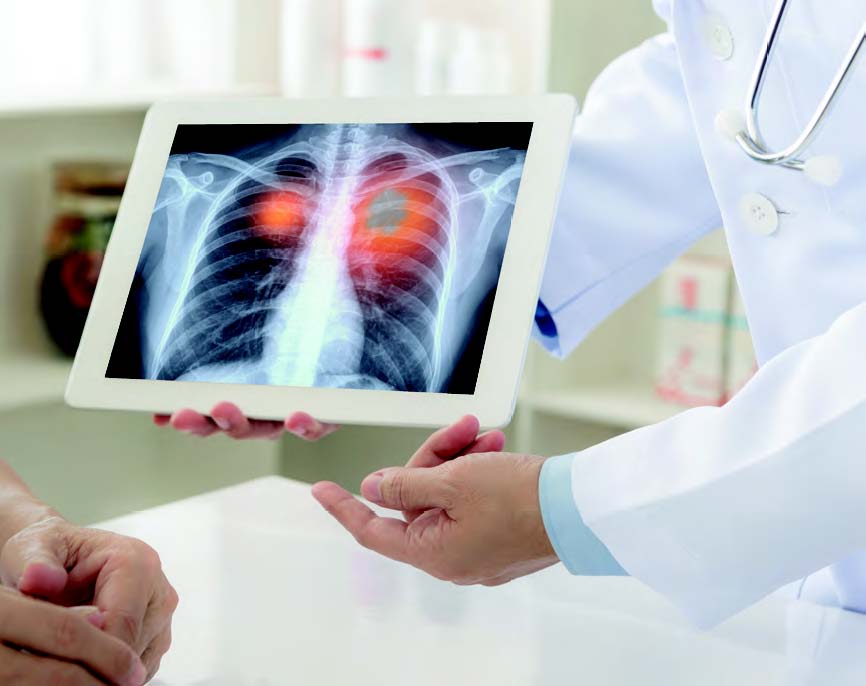
A new procedure uses vapour to destroy diseased segments of the lungs, reducing breathlessness in patients with severe emphysema.
When lungs have been so badly damaged by heavy smoking that coughing and breathlessness are frequent, medications may not completely relieve these symptoms. This is severe chronic obstructive pulmonary disease (COPD), one of the top 10 causes of death in Singapore.
Surgery to remove the most diseased parts of the lung may be necessary to help patients breathe better. The procedure, known as lung volume reduction surgery, is associated with complications such as air leaks and infections; it is not unusual to require extensive rehabilitation before and after the procedure. The severity of the underlying lung condition makes patients susceptible to these complications.
“Approaches via a bronchoscope offer a less invasive option than surgery, with a safer side-effect profile. Several options have been investigated that target an entire lobe of the lungs,” said Dr Anantham Devanand, Senior Consultant, Department of Critical Care and Respiratory Medicine, Singapore General Hospital (SGH).
A new technique now provides similar benefits to bronchoscopic approaches without having to treat an entire lobe of the lungs. “Known as thermal vapour ablation, the approach is very targeted in only treating the most affected segments,” Dr Devanand explained, adding that more of the healthy lung is preserved with this method.
Introduced in SGH in 2018 as an add-on option to standard treatment, thermal vapour ablation is suitable for those suffering from severe emphysema, a type of COPD. In emphysema, the air sacs in the lungs become damaged by smoking, making it difficult for air that was breathed in to be exhaled.
“It’s not that these patients can’t get air into their lungs. They just can’t get it out. Air gets trapped inside the chest, which becomes so full of air that the next breath is hard to get in,” said Dr Devanand.
Breathe better
 A person with healthy lungs easily breathes in and out 12 to 20 times a minute. But for someone with severe emphysema, taking each successive breath becomes more laborious and distressing. Thermal vapour ablation identifies the most over-inflated parts of the lungs for treatment so that the amount of air trapped in the chest is reduced, helping patients breathe more easily.
A person with healthy lungs easily breathes in and out 12 to 20 times a minute. But for someone with severe emphysema, taking each successive breath becomes more laborious and distressing. Thermal vapour ablation identifies the most over-inflated parts of the lungs for treatment so that the amount of air trapped in the chest is reduced, helping patients breathe more easily.
In this procedure, a computed tomography (CT) scan is used to map segments of the lungs to be ablated, and to generate a treatment plan. During the procedure, a bronchoscope is first inserted into the lungs to identify the target segment, then a catheter is inserted through the scope, and hot vapour is delivered to ablate targeted areas.
Performed under general anaesthesia, the procedure takes about 30 minutes, and patients can be discharged the same day. Over the following six weeks, the treated segment will gradually undergo destruction and scarring. Steroids, antibiotics and nebulisers are used to treat any lung infections or COPD attacks that can be expected to occur two to six weeks after the procedure. Patients can have a second vapour ablation if they tolerate the first procedure well.
“The aim of lung volume reduction is about improving symptoms and exercise tolerance,” Dr Devanand advised. Unfortunately, he added, the procedure does not cure COPD.
Stringent criteria
This procedure has stringent eligibility criteria for patients. Among other requirements, they must be diagnosed with severe emphysema or have less than 50 per cent lung function, are not on blood thinners, and are no longer smoking.
These patients would first have their medical care optimised at the COPD clinic helmed by SingHealth respiratory specialists Dr Jessica Tan and Dr Tiew Pei Yee. This care includes smoking cessation, vaccinations, pulmonary rehabilitation, and inhaler therapy. One such patient had a lung function of just 26 per cent. Four months after his first successful treatment, he returned for a second ablation.
Thermal vapour ablation is the latest addition to tools for providing comprehensive management for COPD patients; in the most severe cases, it can serve as a bridge to a lung transplant.













 Get it on Google Play
Get it on Google Play